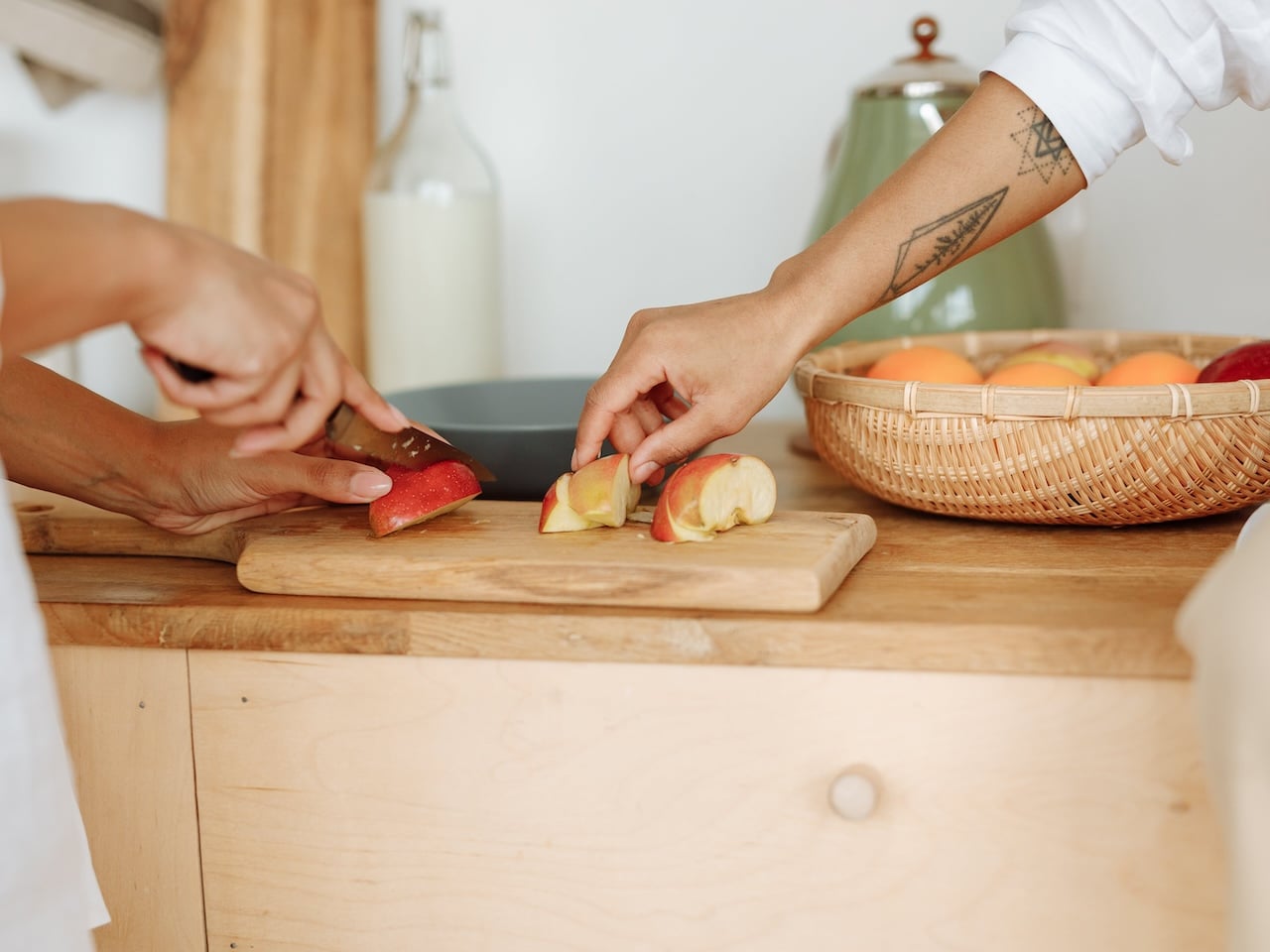
Few fruits present such a variety of shapes, textures, colors and flavors. There are mottled yellow ones, intense green ones and even purplish reddish tones. Some are crispy and light, others have a denser and flourier texture. And there are sweet and juicy ones, or acidic and astringent to the palate. The apple in its many varieties is one of the favorite fruits of the Spanish, only behind the orange. Let’s get to know them a little more!
Nutritional characteristics of apple.
As with all fruits, its main contribution, in addition to water (85.7 grams per 100 grams of edible portion), are the carbohydrates (12 grams), especially in the form of fructose, glucose and sucrose. It is important to remember that these sugars are intrinsic, naturally present and, therefore, healthy. You should not avoid the consumption of fruit – neither this nor any other – because they have sugars. Nothing to do with ‘apple’ products that have added sugars, such as jams, apple pies… Nor, with apple juices, whose sugars are free and whose consumption we must restrict.
The apple contains notable amounts of fiber (2 grams), which makes it an ally to have good digestion and contribute satiety, which in turn helps control appetite. An apple mid-morning, like any other fresh seasonal fruit, is not only a great snack. It can also help avoid other less healthy snacks, such as snacks or pastries, which have a negative impact on health.
In addition, the apple provides us with a wide variety of flavonoid phytochemical substances (flavonols, catechins, procyanidins…) and other bioactive compounds with antioxidant activity. Fresh fruits and vegetables are the main sources of phytochemicals in the diet.
Apple varieties
Scientific literature includes more than a thousand varieties of apples. Miquel Subirà, Category Manager at ALDI, points out that “throughout the year we can find more than 15 varieties of apples in a normal supermarket. However, the most common are the ones we all know: Golden, Granny Smith, Royal Gala, Fuji, Pink Lady…”
Which variety is best for each use?
We have already seen that apples can have different colors, different textures and different flavors. That is why it is advisable to choose well before buying.
- To eat bites. One of the great advantages of the apple is that it comes ready to eat (washing it well under the tap, if we are going to peel it, or disinfecting it, as recommended for safe consumption of fruits from AESAN, if we are going to consume it with skin. This applies to any other fruit and vegetable). “The most crunchy varieties when bitten are also the best known and favorite for the consumer: Royal Gala, Golden, Fuji, Pink Lady…”, highlights Subirà.
- For salads. The absolute winner is the Granny Smith apple for its acidic point.
- To roast. In this use, the long-time favorite continues to be the pippin apple, “although the Golden one is also often used a lot.”
- fondues. Cheese or chocolate fondues are a Central European tradition that is increasingly finding its place on our table. Here the expert also opts for Granny Smith.
If they are seasonal, how is it possible that there is Golden all year round?
Apples in Spain They are harvested between August and October. That is, considering their seasonality we could only enjoy them in autumn. However, thanks to the cold rooms It is possible to find them in the fruit shop all year round. “There are varieties that have a series of characteristics, such as hardness, firmness, high sugar level, which, with an adequate storage system in a chamber, we can see them in the store all year round when the harvest is good at the stock level,” he explains. Get on.
The cold rooms in the warehouses not only keep the fruit at temperatures between 0 and 5 degrees. They can also generate a controlled atmosphere, a common form of conservation that consists of reducing the percentage of oxygen in the air and increasing CO2 (remember that both gases are naturally part of the atmosphere we breathe. Here only their proportion is varied) . Under these conditions, apples barely produce ethylene, the gas that many fruits naturally generate to continue ripening after harvest.
This is the secret why apples last so long.
There are fruits that barely last a week even though we keep them in the refrigerator at home. Apples, on the other hand, can last for weeks, especially if we keep them in the fruit drawer of the refrigerator. “The fruit will last more or less depending on the degree of water and sugar they have accumulated. The apple, being a fairly dense fruit, will have better endurance than other fruits such as, for example, strawberries,” the expert points out.
Paradoxically, although they last a long time, they are quite sensitive to impacts. A simple blow, let alone an accidental fall, accelerates its oxidation, that point where the pulp begins to darken and acquire a soft texture. It is not that they pose a food safety risk, but their organoleptic qualities are greatly affected.
This should be taken into account before putting them in your bag or backpack for an excursion. “Most apples are quite hard, there should be no problems carrying them in a purse or backpack. Although there are varieties that are harder than others, we always recommend that the consumer protect the apples from blows that cause them to lose their integrity,” he points out. A good way to avoid accidents is Carry them in a small lunch box or cotton bag.
This is how you have to keep them at home
The apples are kept in the fruit bowl or in the refrigerator. Subirà remembers that “as happens with most fruits, having the merchandise in a refrigerator will further extend its useful life. If we have them at room temperature, dehydration and loss of turgor of the skin accelerate, as well as its hardness reduces very quickly.”
At room temperature, apples produce a lot of ethylene, “which
It can cause other fruits around it to ripen earlier than expected.” This quality must be kept in mind if there are other more delicate fruits nearby, such as plums, Paraguayans or strawberries, as it could shorten its duration.
What if we have apples that are bruised or have wrinkled skin? The solution is the recipes for use to avoid food waste. The expert suggests giving free rein to your imagination: «Compotes, purees, sauces, juices, smoothies, pastries or even cakes, are always great options to give value to ‘touched’ fruits and prevent them from ending up in the trash.» In fact, the apple is one of the best fruits to blend with dairy, oatmeal, peanut butter or other fruits thanks to its consistency and mild flavor.
The entry Types of apple: which one to buy based on flavor? was first published in Nutriiendo.







Your point of view caught my eye and was very interesting. Thanks. I have a question for you.
Your article helped me a lot, is there any more related content? Thanks!